Vulnerability of Selected Soils in the Different Rainfall Areas to Degradation and Excessive Leaching after Winery Wastewater Application
IF 1.1
4区 农林科学
Q4 FOOD SCIENCE & TECHNOLOGY
引用次数: 2
Abstract
A pot trial was conducted to assess the effect of simulated rainfall on six soils with different textures, irrigated with winery wastewater diluted to a chemical oxygen demand (COD) level of 3000 mg/L over one simulated irrigation season. Thereafter, simulated winter rainfall was applied to the pots. The rainfall was simulated according to the long term averages of the regions where the soils originated. Leaching of cations, particularly K+ and Na+ occurred only from four of the six soils when winter rainfall was simulated. In one of the sandy soils, the simulated rainfall was too low to allow leaching. In another soil, high clay content of 35% in combination with low rainfall prevented leaching. In three soils that received the same amount of rainfall, more cations leached from the duplex sandy soil compared to the two other soils. These trends indicated that leaching of cations was a function of soil texture and rainfall. The study showed that in regions with low rainfall, irrigation with winery wastewater would lead to the accumulation of cations thereby increasing soil salinity. The study confirmed that for sustainable use of winery wastewater irrigation in agriculture, different soil types will require individual management in order to avoid or minimize the negative environmental impact on natural resources by wastewater irrigation.不同雨区土壤对酒厂废水处理后土壤退化和过度淋滤的脆弱性
通过盆栽试验,对6种不同质地土壤进行了模拟降雨的效果评估。在一个模拟灌溉季节,用稀释至化学需氧量(COD)水平为3000 mg/L的酒庄废水灌溉。随后,在盆栽上进行了模拟冬季降雨。降雨是根据土壤起源地区的长期平均值来模拟的。在模拟冬季降雨时,6种土壤中只有4种土壤发生阳离子淋滤,特别是K+和Na+淋滤。在其中一个沙质土壤中,模拟降雨量太低,无法进行淋滤。在另一种土壤中,粘土含量高达35%,加上降雨量少,防止了淋溶。在降雨量相同的三种土壤中,与其他两种土壤相比,双重沙质土壤中阳离子的淋滤量更多。这些趋势表明,阳离子淋滤是土壤质地和降雨的函数。研究表明,在降雨量少的地区,用酒厂废水灌溉会导致阳离子的积累,从而增加土壤盐分。研究证实,为了在农业中可持续利用酒庄废水灌溉,不同的土壤类型需要进行个别管理,以避免或尽量减少废水灌溉对自然资源的负面环境影响。
本文章由计算机程序翻译,如有差异,请以英文原文为准。
求助全文
约1分钟内获得全文
求助全文
来源期刊
CiteScore
2.50
自引率
7.70%
发文量
1
审稿时长
>36 weeks
期刊介绍:
The South African Journal of Enology and Viticulture (SAJEV) publishes full-length original Research Papers, Research Notes and Review Papers on all subjects related to enology and viticulture. The SAJEV does not accept articles published in, or submitted to, other journals.

 求助内容:
求助内容: 应助结果提醒方式:
应助结果提醒方式:


